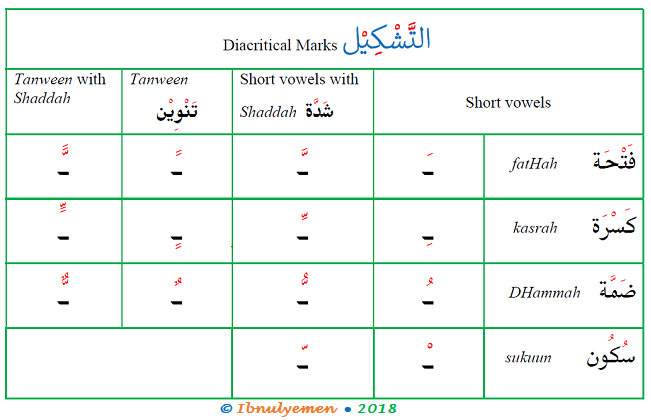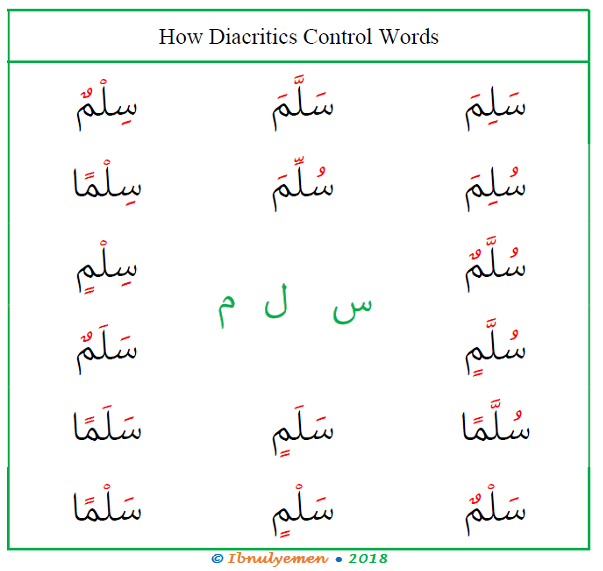Basic Arabic: Diacritical Marks Posted by Ibnulyemen اِبْنُ اليَمَن on Sep 25, 2018 in Grammar, Pronunciation, Vocabulary
In an earlier post, you learned that short vowels الحَرَكَات القَصِيْرَة in Arabic are not represented by letters; rather, they are diacritical marks that are placed over or below regular consonant letters. These short vowels are the fatHah الفَتْحَة, the kasrah الكَسْرَة, and the DHammah الضَّمَّة. In addition, there are two other essential marks: the sukuun السُّكُون and the shaddah الشَّدَّة. A less common diacritical mark is the tanween التَّنْوِيْن. This post provides you with the basic information that you need to know about diacritical marks in Arabic.

The above table includes all the diacritical marks in Arabic. The most basic of these are the three short vowels—the fatHah, the kasrah, and the DHammah. The fatHah, pronounced as a, and the DHammah, pronounced as u, are put over the letter, while the kasrah, pronounced as i, is put below it. The sukuun, which is place over the letter, simply indicates the absence of the three short vowels. For an illustration, if we add these four diacritical marks to the letter ف, here is how it will be pronounced:
| فْ = f | فُ = fu | فِ = fi | فَ = fa |
The shaddah indicates the doubling of a letter. It is normally a sequence of two identical letters, the first with sukuun and the second with a short vowel. For instance, the letter م with a shaddah will be written and pronounced in four different ways, as in this example:
|
مْ مْ = مّ mm عَمّ ‘uncle’ شَمّ ‘smell’ ذَمّ ‘insult’
|
مْ مُ = ـمُّـ mmu عَمْمُهُ = عَمُّهُ ‘his uncle’ يَشِمْمُ = يَشِمُّ ‘he smells’ يَذِمْمُ = يَذِمُّ ‘insult’ تَمْمُوا = تَمُّوا ‘they finished’ |
مْ مِ = ـمِّـ mmi عَمْمِي = عَمِّي ‘my uncle’ كُمْمِلَ = كُمِّلَ ‘was finished’ ثَمْمِن = ثَمِّن ‘give a price’ خَمْمِن = خَمِّن ‘to guess’ |
مْ مَ = ـمُّـ mma خَمْمَر = خَمَّرَ ‘to ferment’ كَمْمَلَ = كَمَّلَ ‘to finish’ لَمْمَا = لَمَّا ‘while’ شَمْمَ = شَمَّ ‘to smell’ |
The tanween is a derivation from the three short vowels, so it has three shapes: two fatHah on top of each other ً, pronounced as an, two kasrah on top of each other ٍ, pronounced as in, and two DHammah ٌ next to each other, pronounced as un. The tanween is always put over or below the last letter of singular indefinite nouns to mark indefiniteness. Its assignment has to do with the grammar. That is, singular nouns that occur in an object position are assign the tanween of fatH (fatHah); those that occur in a subject position are assign the tanween of DHamm (DHammah); and those that occur after a preposition are assigned the tanween of kasr (kasrah), as in these examples:
عِنْدِي كِتَابٌ ‘I have a book’
قَرَأَ مُحَمَّدٌ كِتَابًا. ‘Mohammed read a book’
قَرَأَ مُحَمَّدٌ مِنْ كِتَابٍ جَدِيْدٍ. ‘Mohammed read from a new book’
The shaddah with tanween is the doubling of letters that only occur at the end of singular indefinite nouns. The first letter has a sukuun and the second has a tanween, so they are combined into one with the tanween, as in:
عَمًّا ، عَمٍّ ، عَمٌّ ‘an uncle’
شَمًّا ، شَمٍّ ، شَمٌّ ‘a smell’
The fourteen diacritical marks listed in the table above are called عَلَامَات الشَّكْل ‘alaamaat ash-shakl, which literally means the ‘tools of controlling the word’, namely controlling the pronunciation, the meaning, and the grammar.

As you can see in the table above, the use of diacritical marks generates sixteen different words from a single root word that comprises three letters س ل م, the decomposed word in green. The difference between these words is either in meaning or grammar, in addition to pronunciation.
Let’s consider the first three words in the first line in the table. These words have the same component letters, and the only difference between them is the diacritical marks which make them three completely different words with respect to meaning. The first word سَلِمَ salima means ‘to be secure’, the second سَلَّمَ sallama means ‘to surrender’, and the third سِلْمٌ silmun means ‘peace’
Looking at the last line in the table, the meaning of these three words is the same, that is ‘peace’. The different between them is in the tanween, which indicates the function of the word in a sentence. They are nouns, but one occurs in the subject position, one in the object-of-verb position, and one in the object-of-preposition position.
For a native speaker of Arabic, when these words are used in a context, it is easy to understand the difference between them without diacritical marks; however, it is important for a learner of Arabic as an additional language to learn how to use and assign these diacritical marks every time he/she encounters or learns new words. In addition to improving his/her pronunciation, it leads to faster and more enjoyable learning.
Here are more examples of orthographically similar words that are disambiguated by diacritical marks:
| شَرِبَ ‘to drink’ | شُرْب ‘drinking | |
| عَلِمَ ‘to know’ | عَلَم ‘flag’ | عِلْم ‘science’ |
| خَبَر ‘piece of news’ | خَبَّرَ ‘to tell’ | خَبِرَ ‘to experience’ |
| كَتَبَ ‘to write’ | كُتُب ‘books’ | كَتَّبَ ‘to force to write’ |
| دَرْس ‘lesson’ | دَرَسَ ‘to study’ | دَرَّسَ ‘to teach’ |
| دَخْل ‘income’ | دَخَّلَ ‘to force to enter’ | دَخَلَ ‘to enter’ |
| حَسَبَ ‘to calculate’ | حَسِبَ ‘to think / assume’ |
حَسَب ‘decent’ حَسَب ‘according to’ |

Build vocabulary, practice pronunciation, and more with Transparent Language Online. Available anytime, anywhere, on any device.



